The psychology of smiling
-
Charles Darwin and the evolution of emotion
-
Science of facial feedback hypothesis
-
14 different types of smiles
Just like many other practices we’re a dental clinic that recovers lost smiles. Dentistry these days has a strong focus on smiles and National Smile Month that promotes good oral health is one initiative that all about them.
If we look hard enough we can find smiles in all sorts of places but what is the science behind them? What does smiling mean, why do we do it and how do others read our smile?
Charles Darwin – The psychology of smiling
Best known for his evolution theory, Charles Darwin was one of the first to examine the science behind our smiles.
He noted that smiling is truly universal, unlike other physical actions such as body language, or verbal communication, which differs from culture-to-culture.
We all understand a smile and the feelings behind it.
Darwin also distinguished smiling from laughter, although he admitted that both often appear at the same time. He believed laughter was connected more with amusement whereas the smile was a greater sign of happiness.
‘Our brains react to what our body is doing and it can have a knock on affect to our emotions’
And that’s very true. After all, many of us smile because we’re happy and it conveys the emotion of joy to others.
But this is not always the case. Sometimes we can be happy because we smile.
In an article published on the National Smile Month website, it notes for a long time scientists have linked emotions with changes occurring in the body, from an elevated heart rate to flexion of the zygomatic major muscle –that’s smiling to you and me.
It’s called ‘facial feedback hypothesis’. Our brains react to what our body is doing, and it can have a knock-on effect on our emotions. If we put on a smile, whether we’re genuinely happy or not, our brains will interpret it as happiness, and our mood can change accordingly.
Smiles are infectious
Just for the record, it takes 43 muscles to frown but only 17 to smile. So putting a smile on our face, whether we feel like it or not, actually requires much less effort than being miserable.
Smiles can be natural when we’re in a good mood, or fake when we’re not. They can be broad, sincere, dramatic or spontaneous. They can also look different depending on what muscles we use in our face lips, cheeks or eyes.
According to National Smile Week, scientists have found there are 14 different types of smile.
It’s important to remember that, even if we don’t feel happy, smiles really are infectious and there are always plentiful around North Street Dental in Dudley.
For some smiles are a working ‘tool’. One of our patients explained she needed her smile put right because she was a dance teacher and it was central to her communication skills.
You can read Vicky’s case study here.





